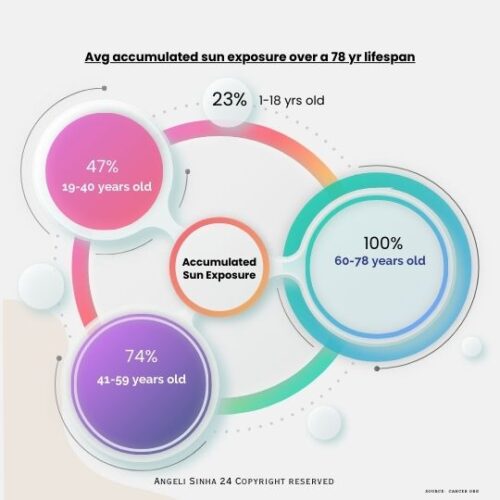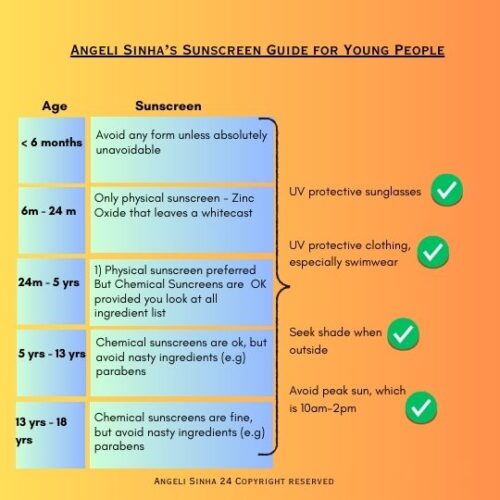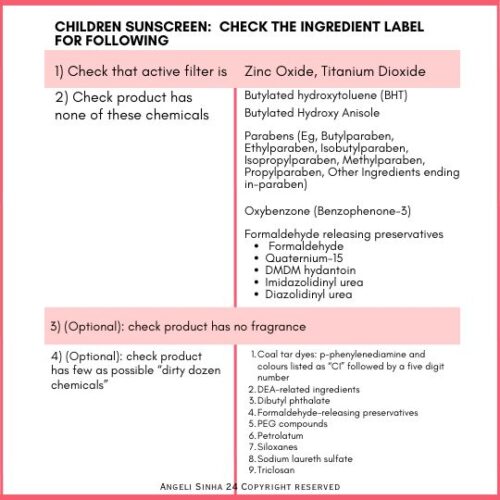Why is sunscreen so critical for kids?
The main reason is that data shows “regular use of sunscreen” reduces the risk of skin cancer. Skin cancer is more prevalent then you imagine. One in 5 Americans will get skin cancer – that’s the American Academy of Dermatology – AND 80% of skin cancers are due to sun exposure under the age of 18. How is that possible? Well, sun damage is CUMULATIVE and this chart shows the Average Accumulated Sun Exposure based on a 78 year life expectancy.

But it’s not enough….
BUT I’ll level with you: Sunscreen does not make your kid’s skin immune to sun damage.
You absolutely still MUST PRACTICE THE FOLLOWING MEASURES: Seek Shade, Wear protective clothing, Avoid peak sun, Wear sunglasses etc etc
What type of sunscreen should I apply? What do I need to know?
BUT today the only focus is on THE TYPE OF SUNSCREEN YOU SHOULD APPLY TO YOUR KID.
I’ll level with you here – if I had a blank page to create a topical product to absorb/block UV radiation SUNSCREENS would be my least favourite choice
WHY?
Because Sunscreens not only contain UV filters (which absorb/reflect/block UV radiation) they are (usually) emulsions that basically contain water, dispersing agents, solvents, preservatives + fragrance. Supergoop (and I have written about this before) have created a silicone oil gel for their transparent range.
“Young children have a larger ratio of skin surface to body volume than adults, which can increase a child’s systemic exposure to topically applied drug products.”
https://www.federalregister.gov/documents/2019/02/26/2019-03019/sunscreen-drug-products-for-over-the-counter-human-use
That is a lot of chemical to repeatedly apply to any child, kid, teenager to prevent skin cancer.
But it’s the only topical option that we have.
Therefore, as parents, guardians I truly believe that you should take the time to educate yourself on this complex product, which serves an important function in preventing skin cancer.
My method – absolutely ignore the blurb
First, you cannot rely on labels such as FOR CHILDREN, DOCTOR RECOMMENDED, DERMATOLOGICALLY APPROVED, PEDIATRICIAN RECOMMENDED
These are marketing claims that have LITTLE regulation and uniformity in meaning.
Method: Age + ingredients in sunscreen
Step 1: What sunscreen should I use based on my kid’s age?
Step 2: What ingredients should I avoid in sunscreens?
Step 1: What sunscreen should I used based on my kid’s age?

Under Six Months
Consensus view is NO sunscreen – and I cant imagine a situation where your kid needs to be slathered in sunscreen – but ok, in that case ONLY apply a non-nano Zinc Oxide sunscreen.
Six Months to 24 Months
The primary form of sun protection should be coming from: protective clothing, hats, shade, avoiding peak sun, sunglasses.
THEN you need to look at the SUNSCREEN you have to buy. You should buy a Zinc Oxide sunscreen that leaves a whitecast. Preferably you want something between the range of 16% – 20% Zinc Oxide.
Why should I look for sunscreens that leave a whitecast?
A Zinc Oxide sunscreen that leaves a whitecast and/or is chalky and/or is difficult to blend is essentially present in a non-nano form. This means the Sunscreen essentially “sits on top of the skin barrier” and is not absorbed into the skin.
(What are nano-ingredients and how can I tell?
A nano ingredient is an incredibly small ingredient: 1 nanometer is about 1,000 times smaller than the strand of your hair.
In physical sunscreens, Zinc Oxide and Titanium Dioxide can be nano in size and you’ll know this
- The ingredient label will say Zinc Oxide (nano), Titanium Dioxide (nano)
- If there is no declaration on the ingredient label then, you’ll know because the sunscreen leaves no whitecast
If you are buying sunscreen for a kid that is physical, make sure it leaves a whitecast.
NOTE that confusingly in the USA, Zinc Oxide and/or Titanium Dioxide containing sunscreens are called PHYSICAL sunscreens. Sunscreens that contain all other filters are called CHEMICAL sunscreen. Ya, I know – zero logic.
24 months to 18 years
My absolute first preference is a NON-NANO ZINC OXIDE SUNSCREEN that leaves a whitecast
BUT as kids get older, their skin barrier becomes more stable and you can look at other sunscreen options
Step 2: What ingredients should I avoid in sunscreens?
Depending on your appetite for risk as a parent, you get to choose which ingredients you apply on your kid. This is the approach that I advocate
Step 2(1): Avoid sunscreens with these Harmful Chemicals
Parabens (see Chemicals to Avoid)
Oxybenzone
Sunscreens with Oxybenzone or Benzophenone-3 Unsuitable for Children
Source: Swedish Research Council.
BHT
Formaldehyde Releasing Preservatives (see this link)
Fragrance – if your kid has sensitive skin
Step 2(2) If you want sunscreen to be clean, then you can follow David Suzuki’s dirty dozen chemicals (but I find this is hard to 100% tick)
(Follow the hyperlink
on each chemical for further information)
-
- Coal tar dyes: p-phenylenediamine and colours listed as “CI” followed by a five digit number
- DEA-related ingredients
- Dibutyl phthalate
- Formaldehyde-releasing preservatives
- PEG compounds
- Petrolatum
- Siloxanes
- Sodium laureth sulfate
- Triclosan
What’s my view on nano ingredients for older kids?
I have not formed my opinion entirely to be honest so watch this space
Don’t forget to subscribe to my newsletter: https://happyskindays.com/subscription/
